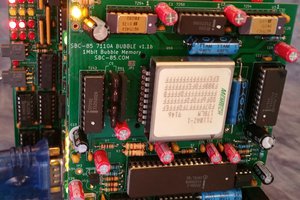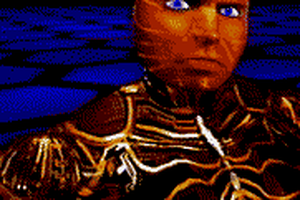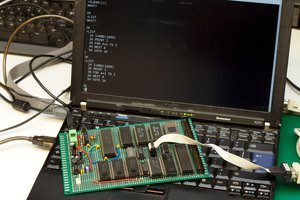Although EBTKS started out as just a solid state replacement for the failing tape drives, its capabilities have expanded far beyond the original goal.
The Features include the following:
- Tape drive emulation, using the 16 GB SD card to store Tape images. Theoretically the SD card could hold about 200,000 tape images. To use this service, the existing tape drive must be disabled by unplugging the two flat-flex cables.
- Disk drive emulation, using the 16 GB SD card to store Disk images. The number of disk images will depend on whether the emulated disk is a floppy or Winchester disk drive. We hope to support multiple disk drive types.
- RAM to fill the top 16 kB of the HP-85A.
- Up to 256 kB of Extended memory for HP85B (EDISK), and HP86/87 computers
- EBTKS provides for up to 18 ROMs to be loaded from the SD card under control of the CONFIG.TXT file. Due to constraints imposed by the System ROMs, only 14 option ROMs are supported (one is system ROM 0). This is sufficient for all 12 standard published Option ROMs. The remainder of the 18 ROMs use a special facility for AUXROMs, discussed later. Currently there are four required AUXROMs which specifically supports EBTKS.
- No Jumper configuration. Configuration of options (like which ROMs are active, initial tape/disk image loaded) is under control of an easily editable CONFIG.TXT file on the SD card.
- Direct access to the CRT to move cursor and read/write text
- Improved auto-start program can include multiple commands or a simple batch file.
- Only requires 1 slot in the I/O backplane
- HELP facility (still in development)
- Diagnostic console using serial-over-USB
- Other features are still in development
- Over 70 New Keywords that include file management, directory management, direct read and write of the SD card with Posix like functions, utility functions to import and export files using GET/SAVE functionality, sprintf() string formatting, and more...
- Hierarchical File System (FAT32 style) that supports long file names, long sub-directory names, and nested sub-directories
- Open source software, can be reviewed now on GitHub
- Open source hardware after the first production batch is shipped
- Coordinated compatibility with Everett's Series 80 Emulator.
For now (and for the future) the best place for the documentation is the link on the left. All the source code is on GitHub.
 Philip
Philip
 fjkraan
fjkraan
 Denver
Denver
 cprossu
cprossu
 Marek Więcek
Marek Więcek